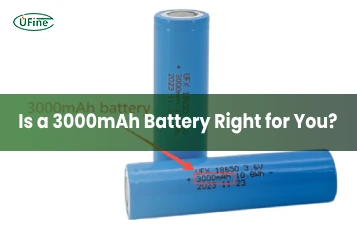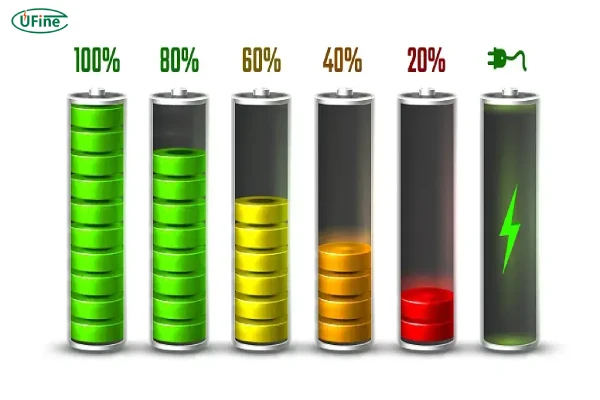At Ufine Battery, we know that optimizing lithium battery power is critical for your operations. Whether you’re managing fleets of electric vehicles, energy storage systems, or industrial equipment, efficient use of battery power leads to lower costs and better performance. In this article, we’ll explore 15 practical tips to help you maximize the lifespan and efficiency of your lithium-ion batteries.
1. Optimize charge cycles
Lithium-ion batteries perform best when they are charged correctly. It’s important to avoid deep discharges and overcharging, as both can reduce battery power over time. For most applications, try to keep the charge between 20% and 80%. This optimizes the lifespan of your lithium batteries, minimizing wear and ensuring better performance. Implementing smart charging systems can help maintain this balance.
Can You Overcharge a Lithium Battery?
2. Use a battery management system (BMS)
A Battery Management System (BMS) is crucial for managing and optimizing the performance of lithium-ion batteries. It ensures that each cell is balanced, maintains safe voltage levels, and prevents overcharging or deep discharge. A good BMS can reduce energy loss and protect your batteries from damage, which ultimately helps save lithium battery power and extends battery life.
3. Temperature control is key
The operating temperature of a lithium battery is one of the most critical factors affecting power efficiency. Extreme temperatures can either cause the battery to degrade faster or reduce its capacity to hold a charge. To optimize battery power, keep your batteries in a temperature-controlled environment. The ideal temperature for lithium-ion batteries is typically between 20°C to 25°C (68°F to 77°F).
4. Switch off unused systems
When managing lithium-powered devices or machines, it’s important to switch off unnecessary systems or components that consume power. Whether it’s a display, lights, or sensors, turning off unused features can save significant battery power. This practice is particularly useful in industrial or off-grid applications where power conservation is critical.
5. Regularly monitor power consumption
Monitoring your lithium battery’s power consumption is one of the most effective ways to optimize performance. Using battery monitoring systems (BMS) helps you track usage patterns, identify inefficiencies, and detect which devices or applications consume the most power. By understanding these patterns, you can make adjustments to reduce consumption and extend battery life.
6. Energy-efficient devices
Choosing energy-efficient devices is a key strategy for reducing the drain on lithium battery power. Whether you’re powering machines, vehicles, or consumer electronics, selecting models with lower power consumption will increase your system’s efficiency. Devices with energy-saving modes or low-power settings can be especially effective in reducing battery drain.
7. Adjust device settings for efficiency
For businesses using lithium batteries in consumer electronics or industrial machinery, adjusting device settings can make a significant difference. Reducing screen brightness, disabling non-essential features, and using battery saver modes can extend battery life. These adjustments can be applied to everything from smartphones to handheld devices used in the field.
8. Avoid constant charging
It’s important not to leave lithium-ion batteries plugged in at all times. Constant charging can cause the battery to heat up, which may lead to faster degradation. Charge only when necessary, and avoid keeping batteries at full charge for extended periods. This will help prevent excessive wear and optimize lithium battery power for the long term.
9. Charge during off-peak hours
If you’re using lithium batteries in energy storage systems, consider charging during off-peak hours when electricity rates are lower and demand on the grid is reduced. This approach can reduce your overall energy costs while ensuring your battery is fully charged for use when needed. Additionally, it helps prevent the overuse of battery power during peak load times.
10. Reduce standby power
Standby power consumption is a significant drain on lithium batteries. Devices or systems that continue to consume power while in idle mode (e.g., smart appliances, networking devices) can waste battery power. To combat this, ensure that systems are fully powered down when not in use, or use smart plugs and switches to cut off power to inactive systems.
11. Use renewable energy sources
Integrating renewable energy sources into your battery-powered systems is a smart way to save lithium battery power. Solar or wind power can be used to charge lithium batteries, reducing dependence on traditional power sources and lowering operational costs. By using renewables, your battery storage systems can work more efficiently and reduce strain on the batteries themselves.
12. Avoid excessive use of high-power applications
High-power applications, such as heavy machinery or high-performance equipment, tend to drain lithium battery power quickly. If possible, reduce the frequency of high-drain operations, or schedule them during times when you can supplement with external power sources. Proper management of high-power applications ensures better overall battery performance.
13. Improve battery storage conditions
When your lithium batteries are not in use, proper storage is key to maintaining battery power. Store your batteries in a cool, dry place, ideally at around 50% charge. This will help prevent the batteries from degrading and losing capacity during long periods of inactivity. Avoid storing them in extreme temperatures or environments that could lead to excessive moisture, which can also damage the battery.
14. Maintain battery hygiene
To maximize the power efficiency of your lithium batteries, keep them clean and free from dirt or debris. Dirt and corrosion on terminals can lead to increased resistance and energy loss. Regularly inspect the terminals and ensure that there are no blockages or damage. Well-maintained batteries perform better and last longer.
15. Understand your battery’s usage patterns
Every lithium battery behaves differently depending on its application. Understanding your battery’s usage patterns and matching the right capacity to your needs can help you avoid unnecessary strain. Keep track of charging cycles, energy demands, and temperature changes to ensure that your batteries are always running at peak efficiency.
Conclusion: a smart approach to saving lithium battery power
By following these 15 tips for saving lithium battery power, you can maximize the lifespan and efficiency of your battery systems. Whether you’re managing a fleet of electric vehicles, overseeing an industrial battery-powered operation, or integrating lithium-ion batteries into renewable energy systems, these strategies will help you optimize performance, cut costs, and improve energy efficiency.
At Ufine Battery, we are committed to providing high-quality lithium batteries that help businesses power their operations sustainably. Get in touch with us today to learn more about how we can help you manage your battery systems more effectively.
Related Tags:
More Articles

Is a 3000 mAh Lithium Battery Enough for Your Device?
Wondering what a 3000mAh battery means? Learn about its power, lifespan, types, and how to choose the best one for your device!
Learn About Lithium Battery Kits
Discover the ultimate guide to lithium battery kits—types, safety, installation, and cost analysis. Make the right choice for solar, RV, or off-grid power!
Selecting the Perfect Ah for Your 48V Li-ion Battery Pack
Struggling to choose the right Ah for your 48V Li-ion battery pack? This in-depth guide covers everything you need to make the best choice. Find out more now!
LiFePO4 Pouch Cells Explained: Advantages, Applications & Comparison
Learn all about LiFePO4 pouch cells, their structure, lifespan, advantages, and how they outperform other lithium battery types. Make the right choice!
12Ah Lithium Battery Guide: Uses, Lifespan & Tips
12Ah lithium batteries last longer, charge faster & weigh less than lead-acid. See best uses, charging tips & how to extend lifespan!




